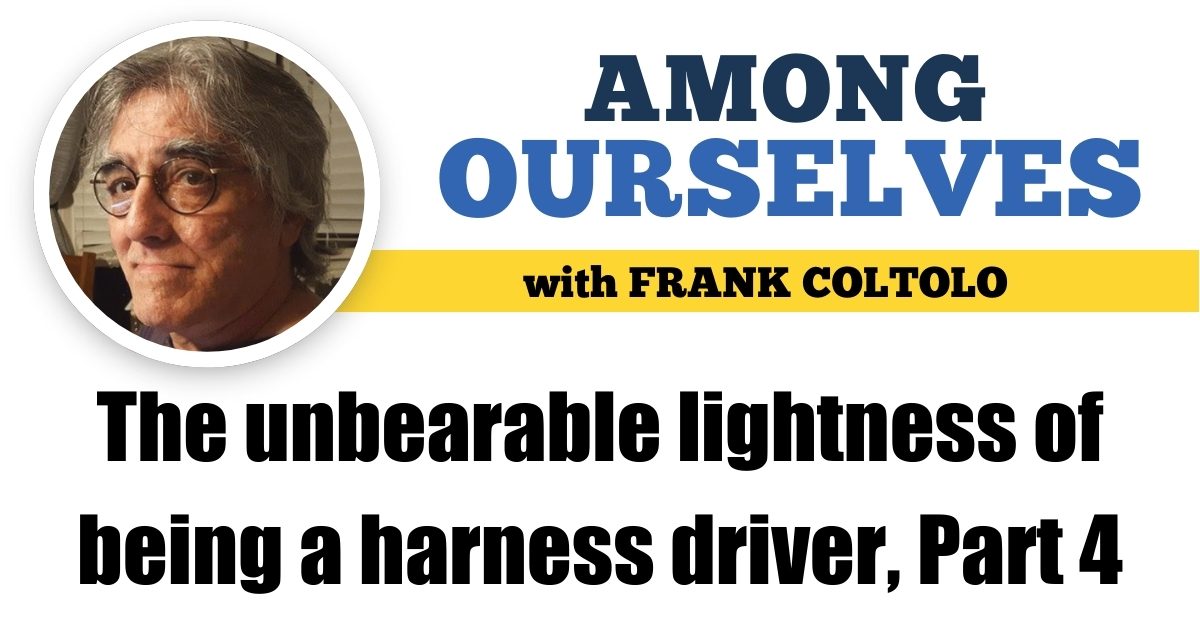The unbearable lightness of being a harness driver, Part 4
by Frank Cotolo
Part 1 is here.
Part 2 is here.
Part 3 is here.
One particular thing I was told that best affected my handicapping career came from a juggler. Let’s call him Delaney. His act incorporated humor; his stage character acted no smarter than a bag of magnets while orchestrating dangerous flying objects with flawless precision. Delaney said, “Most people appreciate what I do because they see my stage character as stupid. But let me tell you something; you can’t be stupid and be a juggler.”
I believe the same for a harness driver. But most harness bettors I met over decades were sure they know the skill of driving pacers and trotters well enough to indict drivers for performances not benefitting their handicapping skills (which incidentally are never officially earned). Of course this is not intrinsic to harness racing. Disappointed fans and sports bettors have used derogatory terms to describe professionals even before the 1919 Black Sox scandal.
Talking with Catello Manzi and other professional drivers after watching them drive thousands of times made me realize being smart is a given for all of them and they should be measured equally. That should be all a handicapper needs to know.
What follows is the continuation of my interview (see part 3 above) with Catello Manzi for YouBet in the early 2000s.
ME: How often do you make split decisions leaving the gate if a horse surprises you wanting to leave or take back?
MANZI: A driver has got to stay loose. Be ready for surprises. The driver has to react to a horse’s unexpected moves. It goes on all the time where a horse has no intention of leaving but I can tell if the horse wants to race well [regardless] and I help make things work out.
ME: Planning is good but adjusting to any plan is negotiable.
MANZI: Sure. Three out of 10 times or more a driver changes his mind about plans made before the race.
ME: Do you ever have to follow what trainers say you should do when driving their stock?
MANZI: Some trainers will do that, and if a driver wants to work again, he has to go along with it.
ME: Would you ever disagree with a trainer telling you how to drive a particular horse?
MANZI: You can talk about it but some of them have their own ideas. I just say I’ll try to do what they want me to do.
ME: Do you think it’s a modern driving tactic to want to be up front early?
MANZI: There’s no question about drivers wanting to be up front, if not in front, early. It’s a perception that it’s the best when beginning a race. But a driver has to make adjustments because if there’s 10 horses in a race not all of them can be in front early.
ME: Do you remember times when your horse was sixth or seventh at the start and you didn’t rush because you knew you still had a good chance to win from behind?
MANZI: Yes. Today a lot of standardbreds are driven more like thoroughbreds. It’s about speed over strategy.
ME: If you get a drive for the first time on a horse not doing so well lately, can a bettor expect you are going to take a different approach for success?
MANZI: Absolutely. If I’m driving a horse that looks to go to the front all the time, I’m going to try not to do that. I’m not going to ride a horse a certain way [if it has been losing]. But I’m not different from a lot of drivers who would try to make some kind of [positive] adjustment.
ME: Do you approach driving a classy horse in stakes race differently than a common overnight horse?
MANZI: Since stakes horses keep racing the same types, a driver gets to know what each one is capable of doing. Overnight horses race against different horses all the time so it’s hard to gauge them.
ME: Is driving a stakes race more stressful for you?
MANZI: Hard to say because in stakes fields of eight to 10 horses there are usually eight to 10 excellent drivers.
ME: Do you prefer a certain size track?
MANZI: No. All it takes is a good horse for me. If I have a good horse, I don’t care if we go down a turnpike racing.
ME: The horse could have a preference, right?
MANZI: Yes. The horse has to be able to handle a certain sized track.
ME: Do you feel hopeless if you know the horse does not like four turns compared to three, etcetera?
MANZI: Not hopeless.
ME: What about driving pacers versus trotters on a certain sized track?
MANZI: There are certain trotters that go good on a half mile as well as a mile. I don’t have a preference. As long as they’re good it doesn’t matter to me. Overall, you have to be a little more careful with trotters because even with hopples they break [more so than pacers].
The worst comment I ever heard about a harness driver came from a professional in the business who said, “He couldn’t drive a starving rat into a cheese factory.”
















